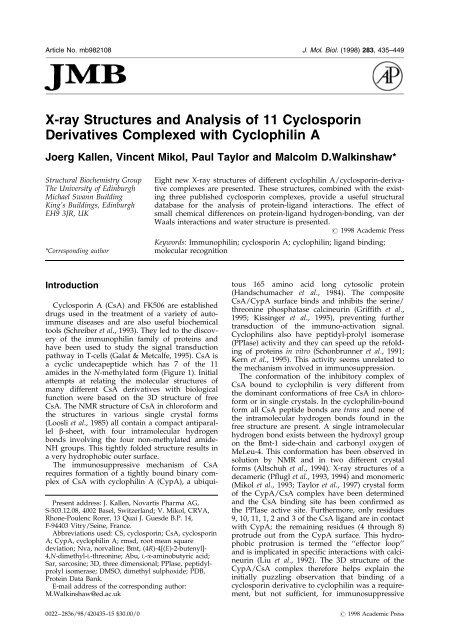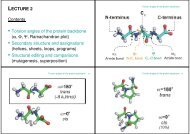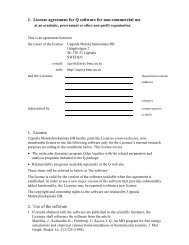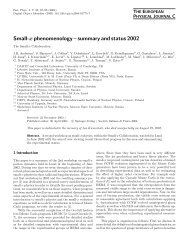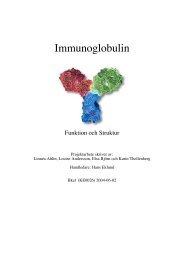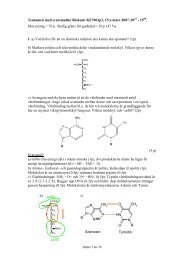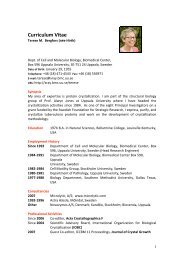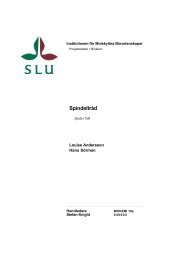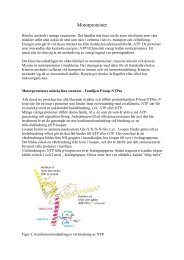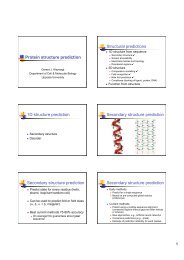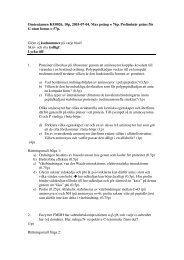X-ray Structures and Analysis of 11 Cyclosporin Derivatives ...
X-ray Structures and Analysis of 11 Cyclosporin Derivatives ...
X-ray Structures and Analysis of 11 Cyclosporin Derivatives ...
You also want an ePaper? Increase the reach of your titles
YUMPU automatically turns print PDFs into web optimized ePapers that Google loves.
Article No. mb982108 J. Mol. Biol. (1998) 283, 435±449<br />
X-<strong>ray</strong> <strong>Structures</strong> <strong>and</strong> <strong>Analysis</strong> <strong>of</strong> <strong>11</strong> <strong>Cyclosporin</strong><br />
<strong>Derivatives</strong> Complexed with Cyclophilin A<br />
Joerg Kallen, Vincent Mikol, Paul Taylor <strong>and</strong> Malcolm D.Walkinshaw*<br />
Structural Biochemistry Group<br />
The University <strong>of</strong> Edinburgh<br />
Michael Swann Building<br />
King's Buildings, Edinburgh<br />
EH9 3JR, UK<br />
*Corresponding author<br />
Eight new X-<strong>ray</strong> structures <strong>of</strong> different cyclophilin A/cyclosporin-derivative<br />
complexes are presented. These structures, combined with the existing<br />
three published cyclosporin complexes, provide a useful structural<br />
database for the analysis <strong>of</strong> protein-lig<strong>and</strong> interactions. The effect <strong>of</strong><br />
small chemical differences on protein-lig<strong>and</strong> hydrogen-bonding, van der<br />
Waals interactions <strong>and</strong> water structure is presented.<br />
# 1998 Academic Press<br />
Keywords: Immunophilin; cyclosporin A; cyclophilin; lig<strong>and</strong> binding;<br />
molecular recognition<br />
Introduction<br />
Present address: J. Kallen, Novartis Pharma AG,<br />
S-503.12.08, 4002 Basel, Switzerl<strong>and</strong>; V. Mikol, CRVA,<br />
Rhone-Poulenc Rorer, 13 Quai J. Guesde B.P. 14,<br />
F-94403 Vitry/Seine, France.<br />
Abbreviations used: CS, cyclosporin; CsA, cyclosporin<br />
A; CypA, cyclophilin A; rmsd, root mean square<br />
deviation; Nva, norvaline; Bmt, (4R)-4[(E)-2-butenyl]-<br />
4,N-dimethyl-L-threonine; Abu, L-a-aminobutyric acid;<br />
Sar, sarcosine; 3D, three dimensional; PPlase, peptidylprolyl<br />
isomerase; DMSO, dimethyl sulphoxide; PDB,<br />
Protein Data Bank.<br />
E-mail address <strong>of</strong> the corresponding author:<br />
M.Walkinshaw@ed.ac.uk<br />
<strong>Cyclosporin</strong> A (CsA) <strong>and</strong> FK506 are established<br />
drugs used in the treatment <strong>of</strong> a variety <strong>of</strong> autoimmune<br />
diseases <strong>and</strong> are also useful biochemical<br />
tools (Schreiber et al., 1993). They led to the discovery<br />
<strong>of</strong> the immunophilin family <strong>of</strong> proteins <strong>and</strong><br />
have been used to study the signal transduction<br />
pathway in T-cells (Galat & Metcalfe, 1995). CsA is<br />
a cyclic undecapeptide which has 7 <strong>of</strong> the <strong>11</strong><br />
amides in the N-methylated form (Figure 1). Initial<br />
attempts at relating the molecular structures <strong>of</strong><br />
many different CsA derivatives with biological<br />
function were based on the 3D structure <strong>of</strong> free<br />
CsA. The NMR structure <strong>of</strong> CsA in chlor<strong>of</strong>orm <strong>and</strong><br />
the structures in various single crystal forms<br />
(Loosli et al., 1985) all contain a compact antiparallel<br />
b-sheet, with four intramolecular hydrogen<br />
bonds involving the four non-methylated amide-<br />
NH groups. This tightly folded structure results in<br />
a very hydrophobic outer surface.<br />
The immunosuppressive mechanism <strong>of</strong> CsA<br />
requires formation <strong>of</strong> a tightly bound binary complex<br />
<strong>of</strong> CsA with cyclophilin A (CypA), a ubiquitous<br />
165 amino acid long cytosolic protein<br />
(H<strong>and</strong>schumacher et al., 1984). The composite<br />
CsA/CypA surface binds <strong>and</strong> inhibits the serine/<br />
threonine phosphatase calcineurin (Grif®th et al.,<br />
1995; Kissinger et al., 1995), preventing further<br />
transduction <strong>of</strong> the immuno-activation signal.<br />
Cyclophilins also have peptidyl-prolyl isomerase<br />
(PPIase) activity <strong>and</strong> they can speed up the refolding<br />
<strong>of</strong> proteins in vitro (Schonbrunner et al., 1991;<br />
Kern et al., 1995). This activity seems unrelated to<br />
the mechanism involved in immunosuppression.<br />
The conformation <strong>of</strong> the inhibitory complex <strong>of</strong><br />
CsA bound to cyclophilin is very different from<br />
the dominant conformations <strong>of</strong> free CsA in chlor<strong>of</strong>orm<br />
or in single crystals. In the cyclophilin-bound<br />
form all CsA peptide bonds are trans <strong>and</strong> none <strong>of</strong><br />
the intramolecular hydrogen bonds found in the<br />
free structure are present. A single intramolecular<br />
hydrogen bond exists between the hydroxyl group<br />
on the Bmt-1 side-chain <strong>and</strong> carbonyl oxygen <strong>of</strong><br />
MeLeu-4. This conformation has been observed in<br />
solution by NMR <strong>and</strong> in two different crystal<br />
forms (Altschuh et al., 1994). X-<strong>ray</strong> structures <strong>of</strong> a<br />
decameric (P¯ugl et al., 1993, 1994) <strong>and</strong> monomeric<br />
(Mikol et al., 1993; Taylor et al., 1997) crystal form<br />
<strong>of</strong> the CypA/CsA complex have been determined<br />
<strong>and</strong> the CsA binding site has been con®rmed as<br />
the PPIase active site. Furthermore, only residues<br />
9, 10, <strong>11</strong>, 1, 2 <strong>and</strong> 3 <strong>of</strong> the CsA lig<strong>and</strong> are in contact<br />
with CypA; the remaining residues (4 through 8)<br />
protrude out from the CypA surface. This hydrophobic<br />
protrusion is termed the ``effector loop''<br />
<strong>and</strong> is implicated in speci®c interactions with calcineurin<br />
(Liu et al., 1992). The 3D structure <strong>of</strong> the<br />
CypA/CsA complex therefore helps explain the<br />
initially puzzling observation that binding <strong>of</strong> a<br />
cyclosporin derivative to cyclophilin was a requirement,<br />
but not suf®cient, for immunosuppressive<br />
0022±2836/98/420435±15 $30.00/0 # 1998 Academic Press
436 <strong>Cyclosporin</strong> <strong>Derivatives</strong> Complexed with CypA<br />
Table 1. Formulae <strong>of</strong> CsA analogues <strong>and</strong> their biological<br />
activities<br />
Figure 1. Residue labelling scheme for CsA-analogues<br />
(see also Table 1). Atom labelling is according to the<br />
IUPAC convention. CN is the methyl carbon atom <strong>of</strong><br />
the N-methylated amino acids. MLE for MeLeu; MVA<br />
for MeVal; BMT for MeBmt; ABU for Abu; SAR for Sar;<br />
VAL for Val; ALA for Ala; DAL for D-Ala. All amino<br />
acid residues with the exception <strong>of</strong> D-Ala8 (<strong>and</strong> Sar3)<br />
are in the L-con®guration.<br />
activity (Sigal et al., 1991). Even small chemical<br />
changes to residues <strong>of</strong> the effector loop can destroy<br />
the immunsuppressive effect without reducing the<br />
ability to bind cyclophilin (Papageorgiou et al.,<br />
1994a).<br />
This paper describes the structures <strong>of</strong> eight<br />
chemically distinct CsA-analogues complexed with<br />
CypA which show modi®cations in both the cyclophilin-binding<br />
residues <strong>and</strong> the effector loop.<br />
A comparison <strong>of</strong> each complex with the native<br />
CypA/CsA structure shows differences in conformation,<br />
molecular rigidity <strong>and</strong> water binding. This<br />
small library <strong>of</strong> closely related lig<strong>and</strong> structures<br />
also provides a picture <strong>of</strong> the frequently unpredictable<br />
effects <strong>of</strong> small chemical changes on 3D structure<br />
<strong>and</strong> biological activity.<br />
Results<br />
Side-chains for the amino acids at position 1, 2, 3 <strong>and</strong> 4 are<br />
shown for the <strong>11</strong> different CsA derivative complexes. The horizontal<br />
line represents the Ca-C b bond for the side-chain. The<br />
CypA value in column 6 gives a measure <strong>of</strong> the strength <strong>of</strong><br />
binding <strong>of</strong> the derivative relative to CsA value in column 6<br />
gives a measure <strong>of</strong> the strength <strong>of</strong> binding <strong>of</strong> the derivative<br />
relative to CsA as determined using an ELISA assay<br />
(Quesniaux et al., 1988). The measure <strong>of</strong> the effect <strong>of</strong> suppressing<br />
the production <strong>of</strong> interleukin-2 relative to CsA in a whole<br />
cell assay is given in the column labeled IL2 (Fliri et al., 1993;<br />
Bollinger et al., 1990).<br />
CsA ˆ Abu2-CS; <strong>11</strong>6450 ˆ MeBm 2 t-CS; 33804 ˆ Val2-CS;<br />
27402 ˆ Thr2-CS; 224698 ˆ (5-hydroxy)Nva2-CS; 209313 ˆ<br />
D-MeSer3-CS; 209650 ˆ Val2-D-MeAla3-CS; 209217 ˆ Val2-D-(2-<br />
S-methyl) Sar3-CS; 209825 ˆ (6,7-dihydro)MeBmt-1-Val2-D-(2-<br />
S-methyl)Sar3-CS; 2<strong>11</strong>810 ˆ (4-hydroxy)MeLeu4-CS; 2<strong>11</strong>8<strong>11</strong> ˆ<br />
MeIle4-CS.<br />
a IC 50 (derivative)/IC 50 CsA.<br />
b 26 times less binding than CsA.<br />
c 4.2 times less immunosuppressive than CsA.<br />
d Three times better binding than CsA.<br />
X-<strong>ray</strong> results<br />
X-<strong>ray</strong> structures <strong>of</strong> a total <strong>of</strong> <strong>11</strong> cyclosporines cocrystallised<br />
with cyclophilin are presented. The labelling<br />
scheme is shown in Figure 1 <strong>and</strong> chemical<br />
structures <strong>of</strong> the cyclosporines are described in<br />
Table 1. For completeness, these include three previously<br />
published structures: native CsA (Mikol<br />
et al., 1993), <strong>11</strong>6450 ((4-methyl)MeBmt1-CS) (Mikol<br />
et al., 1994) <strong>and</strong> 224698 ((5-hydroxy)Nva2-CS)<br />
(Mikol et al., 1995). Most <strong>of</strong> the CypA/CsA-analogue<br />
complexes were grown using a cross-seeding<br />
technique (Mikol & Duc, 1994). These crystals<br />
grew isomorphously with space group P2 1 2 1 2 1<br />
<strong>and</strong> cell dimensions a ˆ 36.4 AÊ , b ˆ 60.7 AÊ ,<br />
c ˆ 72.2 AÊ . The re®ned cell dimensions for the<br />
different isomorphous complexes containing CsAanalogues<br />
varied by a maximum <strong>of</strong> 0.6 AÊ in the a-<br />
dimension, 1.6 AÊ in the b-dimension <strong>and</strong> 1.4 AÊ in<br />
the c-dimension (see Table 2). The unlig<strong>and</strong>ed<br />
CypA structure showed a shrinkage <strong>of</strong> over 2 AÊ<br />
in the b <strong>and</strong> c-dimensions with a ˆ 36.46 AÊ ,<br />
b ˆ 57.32 AÊ , c ˆ 70.73 AÊ . The complex CypA/<br />
209313 was crystallised in space group P2 1 2 1 2<br />
with unit cell dimensions a ˆ 62.9 AÊ , b ˆ 65.3 AÊ ,<br />
c ˆ 40.8 AÊ .<br />
The <strong>11</strong> structures are re®ned to a resolution <strong>of</strong><br />
between 2.2 AÊ <strong>and</strong> 1.76 AÊ . <strong>and</strong> give R-factors
Table 2. Crystallographic data for the CsA-analogue/CypA complexes<br />
CsA-analogue CsA <strong>11</strong>6450 33804 27402 224698 209313 209650 209217 209825 2<strong>11</strong>810 2<strong>11</strong>8<strong>11</strong><br />
Diffraction data<br />
a (AÊ ) 36.39 36.87 36.40 36.48 36.44 62.90 36.38 36.40 36.40 36.30 36.40<br />
b (AÊ ) 60.72 61.29 61.42 61.57 61.32 65.30 61.07 61.10 60.60 61.10 61.50<br />
c (AÊ ) 72.21 71.99 72.42 72.44 72.58 40.80 72.22 72.60 72.60 72.30 72.20<br />
Measured reflections 21,441 18,609 51,<strong>11</strong>3 61,851 46,587 35,137 33,630 50,210 45.753 51,912 39,927<br />
Unique reflections 8732 7343 13,548 12,724 14,501 <strong>11</strong>,324 <strong>11</strong>,304 14,694 14,288 14,285 10,475<br />
R sym (%) 7.4 5.5 5.3 7.4 4.3 9.0 7.8 6.6 5.8 5.8 9.7<br />
Independent reflection 7428 5915 12,089 12,724 12,145 10,206 9813 13,495 12,960 <strong>11</strong>,904 9334<br />
Resolution (AÊ ) 2.1 2.2 1.86 1.8 1.76 2 1.9 1.8 1.8 1.8 2<br />
Completeness (%) 88.9 84.2 95.7 80.8 87.2 95.4 85.6 94.1 92.3 92.2 91.3<br />
Refinement<br />
No. <strong>of</strong> CsA derivative atoms used 85 86 86 86 87 87 87 88 88 86 85<br />
No. <strong>of</strong> solvent molecules 144 131 178 168 188 86 166 127 151 143 127<br />
2<br />
Average B-value for CypA (AÊ ) 13 13.4 15.1 20.1 14.8 28.7 13.3 15.3 16.4 14.2 15.4<br />
2<br />
Average B-value for Cs derivative (AÊ ) 15.9 20.3 16.9 24.7 16.9 24 15.5 16.5 18.5 15.8 16<br />
2<br />
Average B-value for solvent molecule (AÊ ) 37.2 37.5 32.9 44.8 36.4 45.7 35.2 36.6 40.7 36 34.6<br />
Range <strong>of</strong> spacings (AÊ ) 8.0±2.1 8.0±2.2 8.0±1.86 8.0±1.8 8.0±1.76 8.0±2.0 8.0±1.9 8.0±1.8 8.0±1.8 8.0±1.8 8.0±2.0<br />
R-value 0.167 0.163 0.177 0.186 0.175 0.194 0.186 0.185 0.165 0.163 0.169<br />
rmsd from ideality<br />
Bond length (AÊ ) 0.013 0.031 0.012 c 0.06 0.0<strong>11</strong> c 0.017 0.015 0.014 0.014 0.015<br />
Bond angle ( ) 2.64 2.71 1.59 c 1.88 1.57 c 2.94 2.76 2.78 2.64 2.5 2.77<br />
Chemical formulae for the CsA analogue codes are given in Table 1 <strong>and</strong> Figure 1. The superscript c indicates that the structure was re®ned using the stereochemical data from Engh & Huber<br />
(1991). All other structures used the data in the X-PLOR ®le param19X (BruÈ nger, 1993).
438 <strong>Cyclosporin</strong> <strong>Derivatives</strong> Complexed with CypA<br />
Figure 2. Stereo picture <strong>of</strong> the (2F o F c ) electron density for the Val-2-CS (compound 33804). This is representative<br />
<strong>of</strong> the quality <strong>of</strong> the electron density for all other derivatives.<br />
between 0.15 <strong>and</strong> 0.19 (Table 2). The root mean<br />
square deviation (rmsd) from ideal bond lengths<br />
are between 0.01 AÊ <strong>and</strong> 0.017 a <strong>and</strong> the rmsd from<br />
ideal angles is between 1.6 <strong>and</strong> 2.9 . Figure 2<br />
shows the typical quality <strong>of</strong> electron density<br />
obtained in these structures. The average B-value<br />
for the CsA-analogues vary from 24 AÊ 2 to 16 AÊ 2<br />
which tend to be between 5% <strong>and</strong> 25% higher than<br />
the average B-values <strong>of</strong> the cyclophilin atoms<br />
(Table 2).<br />
Comparison <strong>of</strong> cyclophilin structures<br />
The conformations <strong>of</strong> the cyclophilin molecules<br />
in all the CypA/CsA-analogue structures are in<br />
general very similar. A least squares ®t on to the<br />
596 C,N,C( <strong>and</strong> O main-chain atoms <strong>of</strong> residues 4<br />
to 67 <strong>and</strong> 76 to 160 <strong>of</strong> the CypA/CsA complex was<br />
carried out for all CsA-analogue structures (Table 3<br />
<strong>and</strong> Figure 3). The maximum value <strong>of</strong> 0.218 AÊ is<br />
for the non-isomorphous derivative 209313. For the<br />
ten isomorphous crystal structures, rmsd values<br />
vary between 0.18 AÊ <strong>and</strong> 0.10 AÊ . Apart from the<br />
rather ¯exible N <strong>and</strong> C-terminal residues, few<br />
structures have main-chain atoms which deviate<br />
by more than 1 AÊ from the native. The largest<br />
differences (excluding residues 1 to 3) are summarised<br />
in Table 3. The only other region which shows<br />
signi®cant differences between structures is in the<br />
``70s loop'' (residues 67 to 76 ) which shows atom<br />
displacements <strong>of</strong> up to 1.7 AÊ for main-chain atoms<br />
which can be explained by the interactions<br />
between modi®ed CsA residues <strong>and</strong> this 70s loop.<br />
A comparison <strong>of</strong> lig<strong>and</strong>ed <strong>and</strong> unlig<strong>and</strong>ed cyclophilin<br />
structures shows that CypA adopts a very<br />
well conserved conformation in many different<br />
environments (Braun et al., 1995). The decameric<br />
(P¯ugl et al., 1993) <strong>and</strong> monomeric forms (Mikol<br />
et al., 1993) <strong>of</strong> the CypA/CsA complex, for<br />
example, have an rmsd <strong>of</strong> less than 0.5 AÊ for all<br />
backbone atoms. The rmsd values between the<br />
mean NMR structure <strong>and</strong> the monomer form <strong>of</strong><br />
the crystal structure <strong>of</strong> the CypA/CsA complex are<br />
1.0 AÊ for all CypA <strong>and</strong> CsA backbone atoms, <strong>and</strong><br />
1.6 AÊ when the side-chain atoms are included.<br />
A comparison between CypA in the crystal structures<br />
<strong>of</strong> the monomeric form <strong>of</strong> the CypA/CsA<br />
complex <strong>and</strong> unlig<strong>and</strong>ed CypA (Ke, 1992) for the<br />
13-residue binding site gives rmsd values <strong>of</strong> 0.20 AÊ<br />
<strong>and</strong> 0.74 AÊ for the backbone atoms, <strong>and</strong> for all<br />
non-hydrogen atoms, respectively. Even on binding<br />
<strong>of</strong> a very different peptide lig<strong>and</strong>, N-acetyl-<br />
Ala-Ala-Pro-Ala-N-amidomethylcoumarin (Kallen<br />
& Walkinshaw, 1992), CypA does not signi®cantly<br />
alter its conformation; there is an rmsd ®t <strong>of</strong><br />
0.48 AÊ for all atoms in the 13-residue binding site<br />
when ®tted against the structure <strong>of</strong> the monomeric<br />
crystal form.
<strong>Cyclosporin</strong> <strong>Derivatives</strong> Complexed with CypA 439<br />
Table 3. rmsd ®t <strong>of</strong> CypA structures<br />
<strong>11</strong>6450 0.145 0.222 MeBm1/CH(1.23), Val5/CG1(2.61), MeLeu6/CD1(1.78), all distances
Table 4. CsA . . . CypA interaction distances
All short contacts less than 3.7 AÊ between the CsA-analogue (designated by the numerical code number) <strong>and</strong> CypA are listed. The ®ve protein-lig<strong>and</strong> hydrogen bonds are shaded.
442 <strong>Cyclosporin</strong> <strong>Derivatives</strong> Complexed with CypA<br />
Figure 4. Conserved intermolecular<br />
hydrogen bonds between CsAanalogues<br />
<strong>and</strong> CypA. The conformation<br />
<strong>of</strong> CsA in the CypA/CsA<br />
monomeric X-<strong>ray</strong> crystal structure<br />
is shown. Oxygen <strong>and</strong> nitrogen<br />
atoms <strong>of</strong> CsA are displayed in red<br />
<strong>and</strong> blue, respectively. All the<br />
CypA residues (dark grey bonds)<br />
which form hydrogen bonds (broken<br />
lines) <strong>and</strong> close van der Waals<br />
contacts (thin continuous lines)<br />
with the bound CsA (pale grey<br />
bonds) are shown in their positions<br />
in the crystal structure. Additional<br />
hydrogen bonds are mediated by<br />
water molecules which are also<br />
shown. Distances for these interactions<br />
for the different analogues<br />
are given in Table 4.<br />
water molecules were then de®ned such that each<br />
member <strong>of</strong> a cluster lies within a given radius <strong>of</strong><br />
the centroid <strong>of</strong> the cluster. With a radius <strong>of</strong> 0.5 AÊ ,<br />
there are 22 unique clusters containing a water<br />
molecule from each <strong>of</strong> the <strong>11</strong> structures. Water<br />
molecules are shown in Figure 3. Those water molecules<br />
belonging to the same cluster have been<br />
labeled identically in the deposited co-ordinate<br />
®les. All <strong>of</strong> the 22 most conserved water positions<br />
form at least three hydrogen bonds. <strong>and</strong> two <strong>of</strong> the<br />
water molecules (W30 <strong>and</strong> W27) manage to form<br />
four hydrogen bonds to cyclophilin. The 22 con-<br />
Figure 5. Stereo picture <strong>of</strong> CsA/CypA with the most conserved water molecules. CsA is coloured magenta, CypA<br />
is coloured cyan <strong>and</strong> the <strong>11</strong> water molecules which occur in 10 or <strong>11</strong> <strong>of</strong> the <strong>11</strong> structures discussed in this paper are<br />
shown as labelled yellow spheres. The label corresponds to the number in Table 5 <strong>and</strong> also to the label <strong>of</strong> the water<br />
molecule in the deposited PDB ®le. The position <strong>of</strong> the sphere is the average position <strong>of</strong> the water molecules from<br />
the different structures which all re®ne to within 0.2 AÊ <strong>of</strong> each other.
<strong>Cyclosporin</strong> <strong>Derivatives</strong> Complexed with CypA 443<br />
Table 5. Intermolecular distances for the <strong>11</strong> most conserved<br />
water molecules<br />
W<strong>11</strong>-2 Ala38 O 2.78<br />
W<strong>11</strong>-2 Glu43 N 3.28<br />
W<strong>11</strong>-2 Lys44 N 2.88<br />
W<strong>11</strong>-2 Phe46 O 2.73<br />
W<strong>11</strong>-3 Asn102 OD1 2.88<br />
W<strong>11</strong>-3 Val127 N 3.23<br />
W<strong>11</strong>-3 Asp85 OD2 3.05<br />
W<strong>11</strong>-3 Asn108 OD1 2.80<br />
W<strong>11</strong>-4 Ser51 OG 2.90<br />
W<strong>11</strong>-4 Cys52 O 2.60<br />
W<strong>11</strong>-4 Gly65 N 2.78<br />
W10-8 Phe53 O 2.86<br />
W10-8 Ile156 N 2.85<br />
W10-8 W01-25 O1 2.93<br />
W10-8 W01-604 O1 2.82<br />
W10-8 Thr152 OG1 3.01<br />
W10-9 Leu90 N 3.18<br />
W10-9 W<strong>11</strong>-10 O1 2.88<br />
W10-9 Asn87 OD1 2.83<br />
W10-9 Val128 O 2.97<br />
W<strong>11</strong>-10 Phe88 CA 3.22<br />
W<strong>11</strong>-10 W01-521 O1 2.86<br />
W<strong>11</strong>-10 Val128 N 2.91<br />
W<strong>11</strong>-10 Leu90 O 2.75<br />
W<strong>11</strong>-10 W10-43 O1 3.10<br />
W<strong>11</strong>-10 W01-123 O1 3.20<br />
W<strong>11</strong>-13 Asn106 N 3.22<br />
W<strong>11</strong>-13 Asp85 OD2 2.73<br />
W<strong>11</strong>-13 Thr107 N 2.77<br />
W<strong>11</strong>-13 Gly104 O 2.75<br />
W10-19 W05-121 O1 2.68<br />
W10-19 W01-194 O1 2.52<br />
W10-19 W02-46 O1 2.86<br />
W10-19 W01-698 O1 2.64<br />
W10-19 W01-474 O1 2.87<br />
W10-19 Asp13 OD1 2.82<br />
W10-19 His92 O 2.90<br />
W<strong>11</strong>-23 Glu84 O 2.83<br />
W<strong>11</strong>-23 Glu86 N 2.97<br />
W<strong>11</strong>-23 Thr32 OG1 2.81<br />
W<strong>11</strong>-23 Asn108 ND2 3.03<br />
W10-25 Ala<strong>11</strong>7 O 2.85<br />
W10-25 Gly94 O 3.06<br />
W10-25 His92 C 3.09<br />
W10-25 Cys<strong>11</strong>5 SG 3.30<br />
W10-25 His92 O 3.23<br />
W10-25 His92 CA 3.28<br />
W10-25 His92 CB 3.22<br />
W10-43 W01-153 O1 2.26<br />
W10-43 Gly124 N 3.<strong>11</strong><br />
W10-43 Leu90 O 3.20<br />
W10-43 W<strong>11</strong>-10 O1 3.10<br />
W10-43 His126 O 2.81<br />
Water molecules in the <strong>11</strong> re®ned structures were analysed<br />
<strong>and</strong> classi®ed in clusters as described in the text. Those water<br />
molecules re®ning to a position less than 0.2 AÊ from each other<br />
form a cluster. All distances <strong>of</strong> less than 3.2 AÊ from the averaged<br />
position <strong>of</strong> the 10 or <strong>11</strong> water molecules <strong>and</strong> atoms <strong>of</strong> the<br />
native CypA/CsA complex are given. Water molecules are<br />
labelled Wx y where x is the number <strong>of</strong> water molecules in the<br />
cluster (either 10 or <strong>11</strong>) <strong>and</strong> y is the label <strong>of</strong> the water molecule<br />
shown in Figure 6; it was used to label the water molecule in<br />
the deposited PDB ®le. The positions <strong>of</strong> these water molecules<br />
are shown in Figure 4.<br />
served water molecules make a total <strong>of</strong> 53 hydrogen<br />
bonds directly with the protein, <strong>of</strong> which 15<br />
are hydrogen bonds to side-chain atoms, 20 are<br />
hydrogen bonds to backbone carbonyl atoms <strong>and</strong><br />
17 are hydrogen bonds to main-chain amide nitrogen<br />
atoms. In general, protein structures show a<br />
greater frequency <strong>of</strong> hydration <strong>of</strong> main-chain CˆO<br />
groups compared with NH groups by a ratio <strong>of</strong> 3:1<br />
(Baker & Hubbard, 1984). The unusually high proportion<br />
<strong>of</strong> hydrogen bonds to amide nitrogen<br />
atoms in the 22 conserved water sites in the CypA<br />
structures is explained by the fact that these water<br />
molecules tend to be buried <strong>and</strong> are likely to play<br />
a structural role (Williams et al., 1994; Baker &<br />
Hubbard, 1984).<br />
A more stringent criterion for a water cluster<br />
was made in which the cluster radius was reduced<br />
to 0.2 AÊ . Only <strong>11</strong> water molecules were found in<br />
ten or all <strong>11</strong> <strong>of</strong> the X-<strong>ray</strong> structures <strong>and</strong> these most<br />
strongly conserved water molecules are shown in<br />
Figure 5 with intermolecular distances given in<br />
Table 5. The average temperature factor for the<br />
water molecules in the different structures is<br />
approximately twice the amplitude <strong>of</strong> the CsA<br />
lig<strong>and</strong> (see Table 2).<br />
CypA-CsA complexes with modifications in<br />
CsA at position 2<br />
The Abu-binding pocket<br />
In the CypA/CsA complex <strong>and</strong> indeed in all<br />
derivatives with Abu in position two, the ethyl<br />
side-chain ®ts snugly into the ``Abu-pocket'' <strong>and</strong><br />
makes between <strong>11</strong> <strong>and</strong> 13 van der Waals contacts<br />
(C . . . C
444 <strong>Cyclosporin</strong> <strong>Derivatives</strong> Complexed with CypA<br />
Figure 6. Abu-pocket showing hydrogen bonding <strong>of</strong> conserved water molecules. Picture highlighting the conserved<br />
water molecules W5, W6 <strong>and</strong> W7 in the binding pocket for Abu2. These water molecules are present in nine <strong>of</strong><br />
the complexes examined in this paper. Part <strong>of</strong> the CsA molecule is shown in magenta, water molecules are yellow<br />
<strong>and</strong> hydrogen bonds are drawn in green. W7-Ser<strong>11</strong>0 ˆ 2.75 AÊ , W7-Gly74 ˆ 3.29 AÊ , W7-Asn<strong>11</strong>1 ˆ 3.13 AÊ ,<br />
W5-Asn<strong>11</strong>1 ˆ 3.12 AÊ , W5-Gly109 ˆ 2.87 AÊ , W5-W6 ˆ 3.26 AÊ , W5-Ala101 ˆ 2.70 AÊ , W6-Thr107 ˆ 2.77 AÊ , W6-<br />
W244 ˆ 2.75 AÊ .<br />
59 , 53 for Abu2, Val2 <strong>and</strong> Thr2, which places<br />
Val2:C g0<br />
<strong>and</strong> Thr2:O g in the trans <strong>and</strong> gauche conformations,<br />
respectively. The conformation <strong>of</strong> Thr-<br />
2 is stabilised by a strong 2.7 AÊ intramolecular<br />
hydrogen bond from the g OH to the main-chain<br />
carbonyl oxygen atom. This conformation is clearly<br />
disfavoured in the Val2 structure because <strong>of</strong> steric<br />
interaction between the C g methyl group <strong>and</strong> the<br />
carbonyl oxygen atom. The alternative trans conformation<br />
adopted by Val2 results in a number <strong>of</strong><br />
rather short van der Waals contacts to residues lining<br />
the Abu-binding pocket. In particular there is a<br />
short Val2/CG . . . Gln/NE2 contact <strong>of</strong> 3.56 AÊ .<br />
There is a signi®cant effect <strong>of</strong> this repulsive<br />
interaction on the conformation <strong>of</strong> CypA (Figure 7),<br />
which results in a shift in position <strong>of</strong> the 70s loop<br />
<strong>of</strong> CypA. A comparison with the native CypA/<br />
CsA structure shows a shift in this loop which is<br />
greater than 1.2 AÊ for each <strong>of</strong> the main-chain<br />
atoms <strong>of</strong> residues 69 through 73. This compares<br />
with an average displacement <strong>of</strong> less than 0.2 AÊ<br />
for the corresponding region in all other derivative<br />
structures. These changes, along with the presence<br />
<strong>of</strong> the second C g group in the Abu-binding pocket,<br />
prevent the formation <strong>of</strong> the hydrogen-bonded<br />
water network found in the native structure<br />
(Figure 6). An alternative water hydrogen-bonding<br />
pattern is formed with the Val2C/S complex in<br />
which the water molecule corresponding to W6 in<br />
the native structure moved relative to the native<br />
structure by more than 0.5 AÊ .<br />
The threonine hydroxyl group from Thr2-CS<br />
group in the Abu-binding pocket is involved in<br />
hydrogen bonds to two water molecules, one <strong>of</strong><br />
which is 0.8 AÊ from the conserved W6 position.<br />
Despite these additional hydrogen bonds <strong>and</strong> the<br />
lack <strong>of</strong> steric clash <strong>of</strong> the Thr side-chain in the<br />
Abu-pocket the IC50 increases by a factor <strong>of</strong> 1.4<br />
(Table 1). This corresponds to a small reduction in<br />
binding strength that may be explained by a loss<br />
<strong>of</strong> entropy (rotational freedom) <strong>of</strong> the Thr sidechain.<br />
The Val2 analogue (Figure 7) shows a sixfold<br />
reduction in binding to CypA <strong>and</strong> a corresponding<br />
threefold drop in biological activity in vitro. Again<br />
the entropy loss <strong>of</strong> the Val side-chain on binding<br />
may play a role. In addition, the distortion in the<br />
70s loop found in the Val2/CS complex may also<br />
provide a negative energy term for lig<strong>and</strong> binding.<br />
The precision <strong>of</strong> the atomic positions <strong>of</strong> these structures<br />
is about 0.2 AÊ <strong>and</strong> in many cases small<br />
(0.5 AÊ ) movements <strong>of</strong> protein loops may be signi®cant.<br />
The X-<strong>ray</strong> structure <strong>of</strong> the CypA/224698 complex<br />
which was designed with a modi®cation at<br />
position 2 to enhance speci®city for CypB-binding<br />
(Mikol et al., 1995) shows that the hydroxypropyl<br />
side chain penetrates deep into the Abu-pocket
<strong>Cyclosporin</strong> <strong>Derivatives</strong> Complexed with CypA 445<br />
Figure 7. Overlay <strong>of</strong> CypA/Val2-CS (analogue 33804) <strong>and</strong> CypA/CsA showing close contacts to the 70s loop. The<br />
native CypA/CsA structure is shown in magenta <strong>and</strong> CypA/Val2-CS has atom-type colouring. The CsA lig<strong>and</strong>s are<br />
drawn with thick bonds.The additional branched C b <strong>of</strong> Val2 induces a signi®cant shift in the position <strong>of</strong> the 70s loop.<br />
making one weak additional van der Waals contact<br />
<strong>and</strong> a weak hydrogen bond. Binding <strong>of</strong> 224698 to<br />
CypA was reduced by a factor <strong>of</strong> 7. The displacement<br />
<strong>of</strong> water molecules by the side chain <strong>and</strong> loss<br />
<strong>of</strong> rotational entropy <strong>of</strong> the side chain are again<br />
invoked to explain the overall loss <strong>of</strong> binding.<br />
CsA-analogues with valine at position 2 <strong>and</strong><br />
methyl or S-methyl at position 3<br />
Only four <strong>of</strong> the CsA analogues, namely 33804,<br />
209650, 209217 <strong>and</strong> 209825, have a valine at position<br />
2. All have nearly identical conformations <strong>of</strong><br />
the valine side-chain as that shown in Figure 7.<br />
The effect <strong>of</strong> the additional methyl group <strong>of</strong> the<br />
valine is to push the main-chain atoms <strong>of</strong> residues<br />
69 to 73 (the 70s loop) by over 1 AÊ from the native<br />
Cyp/CsA positions. Despite the additional methyl<br />
group, only two non-bonded contacts <strong>of</strong> less than<br />
3.7 AÊ are made: Gln:NE2 <strong>and</strong> Thr73:O (Table 4),<br />
suggesting that the Abu-binding pocket is not<br />
designed for accommodating b-branched amino<br />
acids.<br />
The three Val2-CS analogues with methyl or<br />
S-methyl side-chains at position 3 all show a<br />
signi®cantly increased relative binding strength for<br />
cyclophilin. This effect can not be explained by the<br />
formation <strong>of</strong> additional van der Waals contacts or<br />
hydrogen bonds between lig<strong>and</strong> <strong>and</strong> protein. The<br />
S-Me side-chains <strong>of</strong> 209217 <strong>and</strong> 209825 hardly<br />
contribute to additional van der Waals interaction:<br />
the terminal methyl group makes one contact<br />
(3/CG . . . Thr73/O ˆ 3.5 AÊ ) while the bulky sulphur<br />
atom does not interact at all with cyclophilin<br />
(Table 4). Similarly, the methyl group <strong>of</strong> D-MeAla3-<br />
CS does not make any contacts <strong>of</strong> less than 3.7 AÊ<br />
with the protein.<br />
D-MeSer3-CS is the only complex in this series<br />
which was grown in a different crystal form<br />
(Table 2). The rms ®t for the 596 backbone atoms<br />
onto the native CypA/CsA structure is 0.22 AÊ<br />
compared to the average <strong>of</strong> 0.13 AÊ for the other<br />
nine structures. The D-MeSer3 side-chain <strong>of</strong> 209313<br />
is within 3.7 AÊ <strong>of</strong> Thr73, but the hydroxyl oxygen<br />
atom points out into the solvent <strong>and</strong> no proteinlig<strong>and</strong><br />
hydrogen bond is made.<br />
The effect on CypA binding by CsA residues<br />
modified at position 3<br />
The CsA derivatives studied in this paper have<br />
methyl, hydroxymethyl, <strong>and</strong> S-methyl groups substituting<br />
the pro-R hydrogen <strong>of</strong> the sarcosine residue<br />
at position 3. All show an approximately tw<strong>of</strong>old<br />
stronger binding to CypA compared with<br />
CsA. <strong>Derivatives</strong> 209650, 209217 <strong>and</strong> 209825 also<br />
have an Abu2Val mutation, which was shown to<br />
reduce binding to CypA by a factor <strong>of</strong> about 6. The<br />
reason for the enhanced binding <strong>of</strong> derivatives<br />
with both hydrophobic or hydrophilic substituents<br />
at position 3 is not clear. There is no obvious pocket<br />
in the protein to accept the residue-3 side-chains<br />
<strong>and</strong> only one or two additional van der Waals contacts<br />
are made between lig<strong>and</strong> <strong>and</strong> protein, even<br />
for the large S-methyl group (Table 4). The X-<strong>ray</strong><br />
structure <strong>of</strong> the 209313/CypA complex shows that<br />
the hydroxy group <strong>of</strong> the D-MeSer3-CS points out<br />
into the solvent <strong>and</strong> forms no direct or water<br />
bridged hydrogen bonds to the protein.<br />
A possible explanation for the anomalous<br />
increase in binding strength comes from the observation<br />
using NMR spectroscopy that unlig<strong>and</strong>ed<br />
D-MeSer3-CS in aqueous solution adopts an exclusively<br />
the CypA-bound conformation (Wenger<br />
et al., 1994). NMR studies <strong>of</strong> native CsA have<br />
shown mixtures <strong>of</strong> signi®cantly different conformers<br />
in solution (Braun et al., 1995). The consistently<br />
better CypA-binding properties <strong>of</strong> these
446 <strong>Cyclosporin</strong> <strong>Derivatives</strong> Complexed with CypA<br />
derivatives may then be explained by a higher concentration<br />
in solution <strong>of</strong> the required binding conformation<br />
compared with native CsA.<br />
CypA/CsA complexes with modifications in<br />
CsA at position 4<br />
The side-chain modi®cations at position 4 for<br />
CsA derivatives 2<strong>11</strong>810 ((4-OH)MeLeu4-CS) <strong>and</strong><br />
2<strong>11</strong>8<strong>11</strong> (MeIle4-CS) do not make any contact with<br />
CypA. The CD1 methyl group <strong>of</strong> MeLeu4 in<br />
2<strong>11</strong>8<strong>11</strong> is tw<strong>of</strong>old disordered with w 2 values <strong>of</strong><br />
60 <strong>and</strong> 180 while there is only one conformation<br />
about the Ca-C b bond with w 1 ˆ 50 . The<br />
X-<strong>ray</strong> structure <strong>of</strong> the complex <strong>of</strong> CypA with<br />
2<strong>11</strong>810 (( 4-OH)MeLeu4-CS) is virtually identical to<br />
that <strong>of</strong> the CypA/CsA complex. It was not possible<br />
on the basis <strong>of</strong> electron density maps or intermolecular<br />
crystal contacts to distinguish between the<br />
OH group <strong>and</strong> the C g methyl groups, but in any<br />
case the g-OH on residue 4 makes no intramolecular<br />
contacts <strong>and</strong> points out into the solvent region.<br />
As in the case <strong>of</strong> derivatives at position 3 it is<br />
dif®cult to explain the small increase in CypAbinding<br />
strength for 2<strong>11</strong>8<strong>11</strong> (Table 1). The sidechain<br />
<strong>of</strong> derivatives at position 4 are even more<br />
remote from the surface <strong>of</strong> CypA <strong>and</strong> again the<br />
only reasonable explanation is that such chemical<br />
modi®cations help stabilise the CypA-bound conformation<br />
in solution. There are, however, no<br />
NMR experiments to support this in the case <strong>of</strong><br />
these derivatives. Position 4 is a very sensitive recognition<br />
site for the CypA/CsA complex by calcineurin.<br />
A branched C b atom is enough to<br />
essentially destroy the calcineurin inhibitory (<strong>and</strong><br />
therefore immunosuppressive) effect. The extent to<br />
which this site can be varied has been explored in<br />
a series <strong>of</strong> synthetic studies (Papageorgiou et al.,<br />
1996) <strong>and</strong> the binding properties <strong>of</strong> a number <strong>of</strong><br />
position 4 derivatives have been compared. The<br />
ability to decouple the cyclophilin inhibitory property<br />
from its immunosuppressive activity by such<br />
modi®cations is <strong>of</strong> potential value in developing<br />
non-immunosuppressant derivatives which prevent<br />
cyclophilin being incorporated into the HIV<br />
protein coat. It has been shown that 2<strong>11</strong>8<strong>11</strong> is a<br />
potentially useful HIV inhibitor which blocks viral<br />
replication (Papageorgiou et al., 1996; Rosenwirth<br />
et al., 1994).<br />
Discussion<br />
In this reported series <strong>of</strong> CsA-analogues, both<br />
the ability to bind cyclophilin <strong>and</strong> the immunosuppressant<br />
activity vary considerably (Table 1). In<br />
general, derivatives at residues 9, 10, <strong>11</strong>, 1 or 2<br />
which change the cyclophilin-binding surface <strong>of</strong><br />
CsA, diminish binding to cyclophilin. This diminished<br />
binding correlates well with a reduction <strong>of</strong><br />
immunosuppressive activity (Wenger, 1985; Fliri<br />
et al., 1993; Sigal et al., 1991). Similarly, modi®cations<br />
<strong>of</strong> residues 4, 5 <strong>and</strong> 6 which comprise the<br />
protruding effector loop can strongly affect immunosuppressant<br />
activity without substantially affecting<br />
cyclophilin binding (Sigal et al., 1991;<br />
Papageorgiou et al., 1994a,b). It is, however, not so<br />
straightforward to correlate all <strong>of</strong> the small structural<br />
changes observed in the different X-<strong>ray</strong> analyses<br />
with the measured CypA/CsA IC50 values.<br />
Various attempts have been made to analyse<br />
protein-lig<strong>and</strong> binding by using a number <strong>of</strong> discrete<br />
linearly related energy terms (Ca¯isch &<br />
Karplus, 1995; Morton & Matthews, 1995; Morton<br />
et al., 1995). An analysis <strong>of</strong> the X-<strong>ray</strong> structures <strong>of</strong> a<br />
set <strong>of</strong> seven peptide lig<strong>and</strong>s bound to HIV-protease<br />
has led to an empirical set <strong>of</strong> energy terms which<br />
accurately describe the binding <strong>of</strong> this training set<br />
(Verkhivker et al., 1995). A simple <strong>and</strong> computationally<br />
very ef®cient scoring function which gives<br />
a good estimate <strong>of</strong> lig<strong>and</strong> binding energies has<br />
been developed (Bohm, 1994). The function correlates<br />
well with observed dissociation constants <strong>and</strong><br />
is implemented in the program Ludi (Bohm, 1992,<br />
1996). The free energy <strong>of</strong> a neutral hydrogen bond<br />
contributes 1.1 kcal mol 1 <strong>and</strong> the free energy<br />
contribution from the interaction between lipophilic<br />
surfaces contributes 0.04 kcal mol 1 AÊ 2 . Each<br />
rotatable bond in the lig<strong>and</strong> which is frozen on<br />
binding to the protein costs 0.33 kcal mol 1 (Bohm,<br />
1994).<br />
Application <strong>of</strong> Bohm's scoring function to the<br />
CypA/CsA complex provides an insight into<br />
the relative importance <strong>of</strong> the different terms in the<br />
recognition <strong>and</strong> binding process. The binding <strong>of</strong><br />
CsA to CypA results in a loss <strong>of</strong> contact surface<br />
area <strong>of</strong> CsA <strong>of</strong> 300 AÊ 2 (Altschuh et al., 1994). This<br />
gives a lipophilic contribution to binding <strong>of</strong><br />
4.2 kcal. The ®ve direct CsA-CypA hydrogen<br />
bonds contribute a total <strong>of</strong> 5.6 kcal mol 1 . An<br />
entropy term due to loss <strong>of</strong> rotational <strong>and</strong> translational<br />
motion <strong>of</strong> the whole lig<strong>and</strong> reduces the binding<br />
energy by 1.3 kcal mol 1 . There are <strong>11</strong> freely<br />
rotatable side-chain bonds in CsA which are frozen<br />
by the interaction with CypA <strong>and</strong> reduce the binding<br />
by 3.6 kcal mol 1 . The total binding energy,<br />
using this simple procedure sums to (<strong>11</strong> 0.33)<br />
‡ 1.3 (300 0.04) (5 1.1) ˆ 12.6 kcal mol 1<br />
<strong>and</strong> corresponds to a K d value <strong>of</strong> 5.9 10 10 M.<br />
The experimental dissociation constant for the<br />
CsA/CypA complex is in the range 10 8 to 10 9 M<br />
(Galat, 1993), which corresponds to binding energies<br />
between 10.9 kcal mol 1 <strong>and</strong> 12.3 kcal<br />
mol 1 . The slight over estimate for binding energy<br />
may be accounted for by the estimate <strong>of</strong> the number<br />
<strong>of</strong> frozen rotatable bonds, as binding will also<br />
to some extent lock the backbone conformation <strong>of</strong><br />
the CsA main-chain. The loss <strong>of</strong> conformational<br />
freedom is particularly dif®cult to estimate for the<br />
binding <strong>of</strong> CsA as it is known known to adopt a<br />
variety <strong>of</strong> conformations in solution (Ko & Dalvit,<br />
1992). Loss <strong>of</strong> rotational freedom <strong>of</strong> an additional<br />
<strong>11</strong> backbone torsion angles (a justi®able compromise<br />
for the partially constrained cyclic CsA molecule)<br />
over compensates <strong>and</strong> reduces the<br />
calculated binding energy to 9.1 kcal mol 1 with a<br />
corresponding K d value <strong>of</strong> 2.1 10 7 M.
<strong>Cyclosporin</strong> <strong>Derivatives</strong> Complexed with CypA 447<br />
Flexibility <strong>of</strong> lig<strong>and</strong> <strong>and</strong> protein may play a signi®cant<br />
role in general recognition <strong>and</strong> binding<br />
process. An analysis <strong>of</strong> a series <strong>of</strong> X-<strong>ray</strong> structures<br />
<strong>of</strong> lysozyme/lig<strong>and</strong> complexes suggested that the<br />
more rigid part <strong>of</strong> the protein template confers<br />
speci®city <strong>of</strong> binding <strong>and</strong> only one shape or conformer<br />
<strong>of</strong> the lig<strong>and</strong> is accepted (Morton &<br />
Matthews, 1995; Morton et al., 1995). However,<br />
neither the lig<strong>and</strong> nor the CypA template show<br />
¯exibility in the family <strong>of</strong> X-<strong>ray</strong> structures discussed<br />
here. The only signi®cant change in CypA<br />
structure occurs with complexes <strong>of</strong> compounds<br />
33804, 209650, 209217 <strong>and</strong> 209825, which have a<br />
valine side-chain at position two. This increased<br />
bulk in the Abu-pocket pushes main-chain atoms<br />
in the 70 s loop by just over 1 AÊ from the native<br />
CypA/CsA position. There may be some inherent<br />
¯exibility in this loop as it shows multiple conformations<br />
in NMR structures <strong>of</strong> the CypA/CsA complex<br />
(Theriault et al., 1993; Spitzfaden et al., 1994).<br />
All other X-<strong>ray</strong> structures <strong>of</strong> CypA with a wide<br />
range <strong>of</strong> different lig<strong>and</strong>s, including peptides <strong>and</strong><br />
in different crystal environments, show a very well<br />
conserved protein conformation (Braun et al.,<br />
1995). CypA provides an example <strong>of</strong> an unyielding<br />
recognition template which may be important for<br />
its role as a PPIase or chaperone protein in the cell.<br />
Small prolyl peptides complexed with CypA are<br />
always bound in the cis conformation, while longer<br />
peptides with an accessible Gly-Pro sequence are<br />
bound in the trans conformation with proline occupying<br />
the position <strong>of</strong> MeVal<strong>11</strong> in the hydrophobic<br />
pocket (Taylor et al., 1997). All the structural results<br />
for the CsA complexes suggest that CsA must be<br />
in the correct conformation in solution before it can<br />
bind to CypA. This could be analogous to the recognition<br />
or escort role played by CypA in the cell<br />
where it only binds selected prolyl peptides.<br />
Materials <strong>and</strong> Methods<br />
Crystallisation<br />
Recombinant human CypA was puri®ed <strong>and</strong> concentrated<br />
to between 15 <strong>and</strong> 20 mg ml<br />
1 (1 mM). CsA analogues<br />
were synthesised using methods described<br />
(Seebach et al., 1993; Wenger et al., 1992; Wenger, 1990)<br />
<strong>and</strong> were dissolved in DMSO to a concentration <strong>of</strong><br />
10 mg ml 1 (8 mM). An equimolar solution <strong>of</strong> CypA <strong>and</strong><br />
CsA analogue was incubated at 310 K for 30 minutes<br />
<strong>and</strong> centrifuged at 14,000 rev min 1 Crystals <strong>of</strong> the<br />
CypA/CsA-analogue complexes were grown by vapour<br />
diffusion at 295 K using the hanging drop method. The<br />
1 ml precipitating solution in the well consisted <strong>of</strong><br />
100 mM Tris-HCl (pH 8.0), 19% (w/v) PEG 8000, 6% (v/<br />
v) DMSO, 0.04% (w/v) NaN 3 . The initial 6 ml drops consisted<br />
50 mM Tris-HCl (pH 8.0), 9.5% PEG 8000, 3%<br />
DMSO, 0.02% NaN 3 , 0.5 mM CsA-analogue <strong>and</strong> 0.5 mM<br />
CypA. In most cases, crystals <strong>of</strong> the complex were prepared<br />
by cross-seeding (Mikol & Duc, 1994). After equilibrating<br />
for four days, individual seeds <strong>of</strong> about 10 mm<br />
from a crushed CypA/CsA crystal were transferred into<br />
the hanging drop. Crystals obtained from cross-seeding<br />
were used to seed at least one subsequent crystallisation<br />
in order to dilute out the effect <strong>of</strong> the CsA in the seed.<br />
X-<strong>ray</strong> diffraction measurements<br />
Crystals were mounted in Debye-Scherrer glass capillary<br />
tubes. X-<strong>ray</strong> intensity data were collected using a<br />
FAST television area-detector diffractometer mounted on<br />
a FR571 rotating-anode generator operating at 40 kV <strong>and</strong><br />
80 mA. The program MADNES was used to process the<br />
data (Messerschmidt & P¯ugrath, 1987).<br />
X-<strong>ray</strong> structure refinement<br />
All structures were re®ned with the program X-PLOR<br />
(BruÈ nger, 1993) using alternating rounds <strong>of</strong> positional<br />
re®nement followed by temperature factor re®nement.<br />
<strong>Structures</strong> were re®ned using the Param19x parameters<br />
(BruÈ nger, 1993) except 33804, 27402 <strong>and</strong> 224698 which<br />
were re®ned using different stereochemical data from<br />
Engh & Huber (1991). The programs O (Jones et al.,<br />
1991) <strong>and</strong> WITNOTP (Widmer, 1997) were used to visualise<br />
the structures <strong>and</strong> ®t electron density maps.<br />
Water molecules were selected from peaks on difference<br />
electron density Fourier maps which had peak<br />
heights greater than 3s <strong>and</strong> which were between<br />
2.1 AÊ <strong>and</strong> 3.4 AÊ from atoms in the current model.<br />
Buried surface areas were calculated using Connolly's<br />
algorithm implemented in the program WITNOTP<br />
(Widmer, 1997). All hydrogen atoms were added in calculated<br />
positions on the CsA derivatives <strong>and</strong> on CypA.<br />
The buried surface is the contact surface area <strong>of</strong> CypA<br />
not accessible to a probe atom <strong>of</strong> radius 1.5 AÊ when the<br />
CsA lig<strong>and</strong> is bound.<br />
Atomic co-ordinates <strong>of</strong> all new structures described<br />
here have been deposited in the Brookhaven Database<br />
with the following accession numbers: 33804, 1cwf;<br />
27402, 1bck; 209313, 1cwh; 209650, 1cwi; 209217, 1cwj;<br />
209825, 1cwk; 2<strong>11</strong>810, 1cwl; 2<strong>11</strong>8<strong>11</strong>, 1cwm.<br />
References<br />
Altschuh, D., Braun, W., Kallen, J., Mikol, V.,<br />
Spitzfaden, C., Thierry, L. C., Vix, O., Walkinshaw,<br />
M. D. & Wuthrich, K. (1994). Conformational polymorphism<br />
<strong>of</strong> cyclosporine-a. Structure, 2, 963±972.<br />
Baker, E. N. & Hubbard, R. E. (1984). Hydrogen-bonding<br />
in globular-proteins. Prog. Biophys. Mol. Biol. 44,<br />
97±179.<br />
Bohm, H. J. (1992). Ludi ± rule-based automatic design<br />
<strong>of</strong> new substituents for enzyme-inhibitor leads.<br />
J. Comput. Aided Mol. Design, 6, 593±606.<br />
Bohm, H. J. (1994). The development <strong>of</strong> a simple empirical<br />
scoring function to estimate the binding constant<br />
for a protein lig<strong>and</strong> complex <strong>of</strong> known 3-dimensional<br />
structure. J. Comput. Aided Mol. Design, 8,<br />
243±256.<br />
Bohm, H. J. (1996). Current computational tools for denovo<br />
lig<strong>and</strong> design. Curr. Opin. Biotechnol. 7, 433±<br />
436.<br />
Bollinger, P., Fliri, H., Hiest<strong>and</strong>, P., Payne, T.,<br />
Quesniaux, V., Schreier, M., Traber, R., Tscherter,<br />
H., Walkinshaw, M., Weber, H., Widmer, H. &<br />
Wenger, R. (1990). Structure-activity studies on<br />
cyclosporine derivatives. Am. Chem. Soc. 200, 173±<br />
MEDI (Abstracts).<br />
Braun, W., Kallen, J., Mikol, V., Walkinshaw, M. D. &<br />
Wuthrich, K. (1995). 3-Dimensional structure <strong>and</strong><br />
actions <strong>of</strong> immunosuppressants <strong>and</strong> their immunophilins.<br />
FESEB J. 9, 63±72.
448 <strong>Cyclosporin</strong> <strong>Derivatives</strong> Complexed with CypA<br />
BruÈ nger, A. T. (1993). X-PLOR Version 3.1: A System for<br />
X-<strong>ray</strong> Crystallography <strong>and</strong> NMR, Yale University<br />
Press, New Haven <strong>and</strong> London.<br />
Ca¯isch, A. & Karplus, M. (1995). Computational combinatorial<br />
chemistry for de-novo lig<strong>and</strong> design ±<br />
review <strong>and</strong> assessment. Perspect. Drug Discov.<br />
Design, 3, 51±84.<br />
Engh, R. A. & Huber, R. (1991). Accurate bond <strong>and</strong><br />
angle parameters for X-<strong>ray</strong> protein-structure re®nement.<br />
Acta Crystallog. sect. A, 47, 392±400.<br />
Fliri, H., Baumann, G., Enz, A., Kallen, J., Luyten, M.,<br />
Mikol, V., Movva, R., Quesniaux, V., Schreier, M.,<br />
Walkinshaw, M., Wenger, R., Zenke, G. & Zurini,<br />
M. (1993). <strong>Cyclosporin</strong>s ± structure-activity-relationships.<br />
Ann. NY Acad. Sci. 696, 47±53.<br />
Galat, A. (1993). Peptidylproline cis-trans-isomerases±<br />
immunophilins. Eur. J. Biochem. 216, 689±707.<br />
Galat, A. & Metcalfe, S. M. (1995). Peptidylproline cis/<br />
trans isomerases. Prog. Biophys. Mol. Biol. 63, 67±<br />
<strong>11</strong>8.<br />
Grif®th, J. P., Kim, J. L., Kim, E. E., Sintchak, M. D.,<br />
Thomson, J. A., Fitzgibbon, M. J., Fleming, M. A.,<br />
Caron, P. R., Hsiao, K. & Navia, M. A. (1995). X-<strong>ray</strong><br />
structure <strong>of</strong> calcineurin inhibited by the immunophilin<br />
immunosuppressant fkbp12±fk506 complex.<br />
Cell, 82, 507±522.<br />
H<strong>and</strong>schumacher, R. E., Harding, M. W., Rice, J. &<br />
Drugge, R. J. (1984). Cyclophilin ± a speci®c cytosolic<br />
binding-protein for cyclosporin-a. Science, 226,<br />
544±547.<br />
Jones, T. A., Zou, J. Y., Cowan, S. W. & Kjeldgaard, M.<br />
(1991). Improved methods for building protein<br />
models in electron-density maps <strong>and</strong> the location <strong>of</strong><br />
errors in these models. Acta Crystallog. sect. A, 47,<br />
<strong>11</strong>0±<strong>11</strong>9.<br />
Kallen, J. & Walkinshaw, M. D. (1992). The x-<strong>ray</strong> structure<br />
<strong>of</strong> a tetrapeptide bound to the active-site <strong>of</strong><br />
human cyclophilin-a. FEBS Letters, 300, 286±290.<br />
Ke, H. M. (1992). Similarities <strong>and</strong> differences between<br />
human cyclophilin-a <strong>and</strong> other beta-barrel structures<br />
± structural re®nement at 1.63 AÊ resolution.<br />
J. Mol. Biol. 228, 539±550.<br />
Kern, G., Kern, D., Schmid, F. X. & Fischer, G. (1995).<br />
A kinetic-analysis <strong>of</strong> the folding <strong>of</strong> human carbonicanhydrase-ii<br />
<strong>and</strong> its catalysis by cyclophilin. J. Biol.<br />
Chem. 270, 740±745.<br />
Kissinger, C. R., Parge, H. E., Knighton, D. R., Lewis,<br />
C. T., Pelletier, L. A., Tempczyk, A., Kalish, V. J.,<br />
Tucker, K. D., Showalter, R. E., Moomaw, E. W.,<br />
Gastinel, L. N., Habuka, N., Chen, X. H.,<br />
Maldonado, F. & Barker, J. E., et al. (1995). Crystalstructures<br />
<strong>of</strong> human calcineurin <strong>and</strong> the human<br />
fkbp12-fk506-calcineurin complex. Nature, 378, 641±<br />
644.<br />
Ko, S. Y. & Dalvit, C. (1992). Conformation <strong>of</strong> cyclosporine-a<br />
in polar-solvents. Int. J. Pept. Protein Res. 40,<br />
380±382.<br />
Liu, J., Albers, M. W., W<strong>and</strong>less, T. J., Luan, S., Alberg,<br />
D. G., Belshaw, P. J., Cohen, P., Mackintosh, C.,<br />
Klee, C. B. & Schreiber, S. L. (1992). Inhibition <strong>of</strong><br />
t-cell signaling by immunophilin lig<strong>and</strong> complexes<br />
correlates with loss <strong>of</strong> calcineurin phosphataseactivity.<br />
Biochemistry, 31, 3896±3901.<br />
Loosli, H. R., Kessler, H., Oschkinat, H., Weber, H. P.,<br />
Petcher, T. J. & Widmer, A. (1985). Peptide conformations<br />
.31. The conformation <strong>of</strong> cyclosporin-a in<br />
the crystal <strong>and</strong> in solution. Helv Chim. Acta, 68,<br />
682±704.<br />
Messerschmidt, A. & P¯ugrath, J. W. (1987). Crystal<br />
orientation <strong>and</strong> x-<strong>ray</strong> pattern prediction routines for<br />
area- detector diffractometer systems in macromolecular<br />
crystallography. J. Appl. Crystallog. 20, 306±<br />
315.<br />
Mikol, V. & Duc, D. (1994). Crystallization <strong>of</strong> the complex<br />
between cyclophilin-a <strong>and</strong> cyclosporine derivatives<br />
± the use <strong>of</strong> cross-seeding. Acta Crystallog. sect.<br />
D, 50, 543±549.<br />
Mikol, V., Kallen, J., P¯ugl, G. & Walkinshaw, M. D.<br />
(1993). X-<strong>ray</strong> structure <strong>of</strong> a monomeric cyclophilina-cyclosporine-a<br />
crystal complex at 2.1 AÊ resolution.<br />
J. Mol. Biol. 234, <strong>11</strong>19±<strong>11</strong>30.<br />
Mikol, V., Kallen, J. & Walkinshaw, M. D. (1994). The<br />
x-<strong>ray</strong> structure <strong>of</strong> (mebm(2)t)(1)-cyclosporine complexed<br />
with cyclophilin-a provides an explanation<br />
for its anomalously high immunosuppressive<br />
activity. Protein Eng. 7, 597±603.<br />
Mikol, V., Papageorgiou, C. & Borer, X. (1995). The role<br />
<strong>of</strong> water-molecules in the structure-based design <strong>of</strong><br />
(5-hydroxynorvaline)-2-cyclosporine ± synthesis, biological-activity,<br />
<strong>and</strong> crystallographic analysis with<br />
cyclophilin-a. J. Med. Chem. 38, 3361±3367.<br />
Morton, A. & Matthews, B. W. (1995). Speci®city <strong>of</strong><br />
lig<strong>and</strong>-binding in a buried nonpolar cavity <strong>of</strong> t4<br />
lysozyme ± linkage <strong>of</strong> dynamics <strong>and</strong> structural plasticity.<br />
Biochemistry, 34, 8576±8588.<br />
Morton, A., Baase, W. A. & Matthews, B. W. (1995).<br />
Energetic origins <strong>of</strong> speci®city <strong>of</strong> lig<strong>and</strong>-binding in<br />
an interior nonpolar cavity <strong>of</strong> t4 lysozyme. Biochemistry,<br />
34, 8564±8575.<br />
Papageorgiou, C., Borer, X. & French, R. R. (1994). Calcineurin<br />
has a very tight-binding pocket for the sidechain<br />
<strong>of</strong> residue-4 <strong>of</strong> cyclosporine. Bioorg. Med.<br />
Chem. Letters, 4, 267±272.<br />
Papageorgiou, C., Florineth, A. & Mikol, V. (1994).<br />
Improved binding-af®nity for cyclophilin-a by a<br />
cyclosporine derivative singly modi®ed at its effector<br />
domain. J. Med. Chem. 37, 3674±3676.<br />
Papageorgiou, C., Sanglier, J. J. & Traber, R. (1996). Anti<br />
hiv-1 activity <strong>of</strong> a hydrophilic cyclosporine derivative<br />
with improved binding-af®nity to cyclophilin-a.<br />
Bioorg. Med. Chem. Letters, 6, 23±26.<br />
P¯ugl, G., Kallen, J., Schirmer, T., Jansonius, J. N.,<br />
Zurini, M. G. M. & Walkinshaw, M. D. (1993).<br />
X-<strong>ray</strong> structure <strong>of</strong> a decameric cyclophilin cyclosporine<br />
crystal complex. Nature, 361, 91±94.<br />
P¯ugl, G. M., Kallen, J., Jansonius, J. N. & Walkinshaw,<br />
M. D. (1994). The molecular replacement solution<br />
<strong>and</strong> x-<strong>ray</strong> re®nement to 2. 8 AÊ <strong>of</strong> a decameric complex<br />
<strong>of</strong> human cyclophilin-a with the immunosuppressive<br />
drug cyclosporine-a. J. Mol. Biol. 244, 385±<br />
409.<br />
Quesniaux, V. F. J., Schreier, M. H., Wenger, R. M.,<br />
Hiest<strong>and</strong>, P. C., Harding, M. W. & Vanregenmortel,<br />
M. H. V. (1988). Molecular characteristics <strong>of</strong> cyclophilin-cyclosporine<br />
interaction. Transplantation, 46,<br />
S23±S28.<br />
Rosenwirth, B., Billich, A., Datema, R., Donatsch, P.,<br />
Hammerschmid, F., Harrison, R., Hiest<strong>and</strong>, P.,<br />
Jaksche, H., Mayer, P., Peichl, P., Quesniaux, V.,<br />
Schatz, F., Schuurman, H. J., Traber, R. & Wenger,<br />
R., et al. (1994). Inhibition <strong>of</strong> human-immunode®ciency-virus<br />
type-1 replication by sdz- nim-8<strong>11</strong>, a<br />
nonimmunosuppressive cyclosporine analog. Antimicrob.<br />
Agents Chemother. 38, 1763±1772.<br />
Schonbrunner, E. R., Mayer, S., Tropschug, M., Fischer,<br />
G., Takahashi, N. & Schmid, F. X. (1991). Catalysis
<strong>Cyclosporin</strong> <strong>Derivatives</strong> Complexed with CypA 449<br />
<strong>of</strong> protein folding by cyclophilins from different<br />
species. J. Biol. Chem. 266, 3630±3635.<br />
Schreiber, S. L., Albers, M. W. & Brown, E. J. (1993).<br />
The cell-cycle, signal-transduction, <strong>and</strong> immunophilin<br />
lig<strong>and</strong> complexes. Acc. Chem. Res. 26, 412±420.<br />
Seebach, D., Beck, A. K., Bossler, H. G., Gerber, C., Ko,<br />
S. Y., Murtiashaw, C. W., Naef, R., Shoda, S.,<br />
Thaler, A., Krieger, M. & Wenger, R. (1993). Modi®cation<br />
<strong>of</strong> cyclosporine-a (cs) ± generation <strong>of</strong> an enolate<br />
at the sarcosine residue <strong>and</strong> reactions with<br />
electrophiles. Helv. Chim. Acta, 76, 1564±1590.<br />
Sigal, N. H., Dumont, F., Durette, P., Siekierka, J. J.,<br />
Peterson, L., Rich, D. H., Dunlap, B. E., Staruch,<br />
M. J., Melino, M. R., Koprak, S. L., Williams, D.,<br />
Witzel, B. & Pisano, J. M. (1991). Is cyclophilin<br />
involved in the immunosuppressive <strong>and</strong> nephrotoxic<br />
mechanism <strong>of</strong> action <strong>of</strong> cyclosporine-a. J. Exp.<br />
Med. 173, 619±628.<br />
Spitzfaden, C., Braun, W., Wider, G., Widmer, H. &<br />
Wuthrich, K. (1994). Determination <strong>of</strong> the nmr solution<br />
structure <strong>of</strong> the cyclophilin-a±cyclosporine-a<br />
complex. J. Biomol. NMR, 4, 463±482.<br />
Taylor, P., Husi, H., Kontopidis, G. & Walkinshaw,<br />
M. D. (1997). <strong>Structures</strong> <strong>of</strong> cyclophilin-lig<strong>and</strong> complexes.<br />
Prog. Biophys. Mol. Biol. 67, 155±181.<br />
Thanki, N., Umrania, Y., Thornton, J. M. & Goodfellow,<br />
J. M. (1991). <strong>Analysis</strong> <strong>of</strong> protein main-chain solvation<br />
as a function <strong>of</strong> secondary structure. J. Mol.<br />
Biol. 221, 669±691.<br />
Theriault, Y., Logan, T. M., Meadows, R., Yu, L. P.,<br />
Olejniczak, E. T., Holzman, T. F., Simmer, R. L. &<br />
Fesik, S. W. (1993). Solution structure <strong>of</strong> the cyclosporine-a<br />
cyclophilin complex by NMR. Nature, 361,<br />
88±91.<br />
Verkhivker, G., Appelt, K., Freer, S. T. & Villafranca, J. E.<br />
(1995). Empirical free-energy calculations <strong>of</strong> lig<strong>and</strong>protein<br />
crystallographic complexes. 1. Knowledgebased<br />
lig<strong>and</strong>-protein interaction potentials applied<br />
to the prediction <strong>of</strong> human-immunode®ciencyvirus-1<br />
protease binding-af®nity. Protein Eng. 8,<br />
677±691.<br />
Wenger, R. M. (1985). Synthesis <strong>of</strong> cyclosporine <strong>and</strong><br />
analogs ± structural requirements for immunosuppressive<br />
activity. Angew<strong>and</strong>te Chemie-Internat. (edition<br />
in English), 24, 77±85.<br />
Wenger, R. M. (1990). <strong>Structures</strong> <strong>of</strong> cyclosporine <strong>and</strong> its<br />
metabolites. Transplant. Proc. 22, <strong>11</strong>04±<strong>11</strong>08.<br />
Wenger, R. M., Martin, K., Timbers, C. & Tromelin, A.<br />
(1992). Structure <strong>of</strong> cyclosporine <strong>and</strong> its metabolites<br />
± total synthesis <strong>of</strong> cyclosporine metabolites<br />
formed by oxidation at position-4 <strong>and</strong> position-9 <strong>of</strong><br />
cyclosporine ± preparation <strong>of</strong> leucine-4-cyclosporine,<br />
(gamma-hydroxy)-N-methyl-leucine-9-cyclosporine<br />
<strong>and</strong> leucine-4-(gamma-hydroxy)-N-methyl-leucine-9-<br />
cyclosporine. Chimia, 46, 314±322.<br />
Wenger, R. M., France, J., Bovermann, G., Walliser, L.,<br />
Widmer, A. & Widmer, H. (1994). The 3D structure<br />
<strong>of</strong> a cyclosporine analog in water is nearly identical<br />
to the cyclophilin-bound cyclosporine conformation.<br />
FEBS Letters, 340, 255±259.<br />
Widmer, A. (1997). WITNOTP: A Computer Program for<br />
Molecular Modelling, S<strong>and</strong>oz AG, Basel.<br />
Williams, M. A., Goodfellow, J. M. & Thornton, J. M.<br />
(1994). Buried waters <strong>and</strong> internal cavities in monomeric<br />
proteins. Protein Sci. 3, 1224±1235.<br />
Edited by I. A. Wilson<br />
(Received 22 December 1997; received in revised form 18 June 1998; accepted 16 July 1998)


